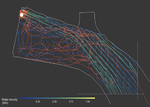SafePass (NO)
 Figures from Szabo-Meszaros et al (2019)
Figures from Szabo-Meszaros et al (2019)
Project Background
SafePass aims to find the best solutions for fish migration in regulated rivers, from the perspectives of both the fish and the hydropower industry.
During the last 150 years, more than 500 fish ladders have been built in Norway, enabling salmonid fishes to pass natural waterfalls and hydropower dams. While some fish ladders might work to some extent, successful passage for inland fish species remain a major challenge and many dams continue to hinder successful migration of brown trout, grayling, salmon, eel and many other species.
The success of helping fish past upstream barriers may be of limited value if the downstream migration of the adults and their offspring is not considered. Fish swimming into hydropower turbines are most often injured or die and it is vital to find alternative downstream migration routes. SafePass will put the spotlight on the problems of downstream migration.
By performing detailed studies of fish behaviour and hydraulic conditions, we will increase our understanding of why fish behave the way they do. Such knowledge is vital for developing solutions. Moreover, we will develop and test new screens that prevent fish from entering turbines and measures that scare fish away from the dangerous migration path and attract them to the safe one. The knowledge will be compiled in a Norwegian handbook for migration solutions, directly applicable for the hydropower industry and management.
High-Resolution Fish Tracking
The SafePass project included tracking various fish species and life stages at four different sites: River Mandal (NO), River Orkla (NO), River Lågen (aka Gudbrandsdalslågen, NO) and River Ätran (SE). Each site was a river stretch heavily impacted by hydropower operation and imposing different challenges.
To track Atlantic salmon (Salmo salar) and brown trout (Salmo trutta) smolt, we used a system from Lotek Wireless operating at 200 kHz, which enables use of very small transmitters suitable for smolt size fishes. For tracking of salmon and trout kelts (post-spawning individuals) and European eels (Anguilla anguilla), we used a Lotek Wireless system operating at 76 kHz, as the larger transmitters from this system could easily be carried by the fish and gave better detection ranges. Both systems enable simultaneous tracking of many (100+) indviduals with high temporal resolution and the option for transmitter-borne sensors - for instance, pressure sensors used to obtain swimming depth of the fish.

Project Partners
The tracking is part of a larger project lead by Dr. Torbjørn Forseth, NINA, Norway



